 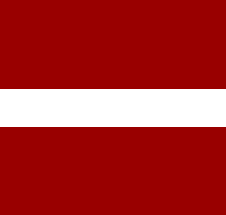 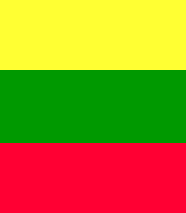 |
Estonia | Part 1 |
| Latvia | ||
| Lithuania |
Friday 29 August 2014
The night before our departure to Estonia we stay at the Citizen M hotel at Schiphol. It is a few minutes walk from Schiphol Plaza and the railway station. We have to check in at a computer terminal and create a room key ourselves. The room is small but inventively designed. The bed faces the window wall to wall. The shower and toilet are in the room and can be closed with sliding glass doors. We have a view of the planes that coming and going. We watch some TV and drink a (free) drink in the bar downstairs. We go to sleep early because we have to get up early tomorrow.
Saturday 30 August 2014
We get up at 5:30am, show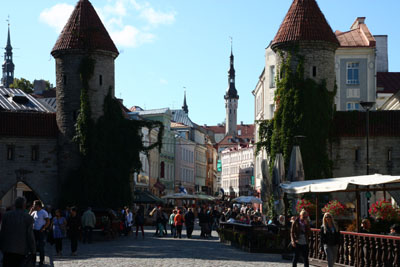 er
and then leave for the airport departure lounge. We check in and go and have
breakfast at the sandwich bar. Next we have coffee at Starbucks. The flight
to Frankfurt departs at 7:40 am. We arrive at 8:50 am in Frankfurt. We have
to change here and our connecting flight to Tallinn departs at 10.05. The
flights go smoothly. At 13.30 local time (+1 hour compared to home) we
arrive at the
Lennart Meri
Airport. We take a taxi from
Tullika Takso
to the Baltic Baltic Vanu Wiru hotel,
arriving some fifteen minutes later, right in the old town. Tulika (and
Tallink Takso and Tallina Takso) are the official taxi's at the airport.
These are lined up at the taxi rank outside the arrivals hall. There are
also less reliable companies who want to approach you in the arrivals hall
and overcharging unsuspecting tourists is no exception. The hotel is
er
and then leave for the airport departure lounge. We check in and go and have
breakfast at the sandwich bar. Next we have coffee at Starbucks. The flight
to Frankfurt departs at 7:40 am. We arrive at 8:50 am in Frankfurt. We have
to change here and our connecting flight to Tallinn departs at 10.05. The
flights go smoothly. At 13.30 local time (+1 hour compared to home) we
arrive at the
Lennart Meri
Airport. We take a taxi from
Tullika Takso
to the Baltic Baltic Vanu Wiru hotel,
arriving some fifteen minutes later, right in the old town. Tulika (and
Tallink Takso and Tallina Takso) are the official taxi's at the airport.
These are lined up at the taxi rank outside the arrivals hall. There are
also less reliable companies who want to approach you in the arrivals hall
and overcharging unsuspecting tourists is no exception. The hotel is
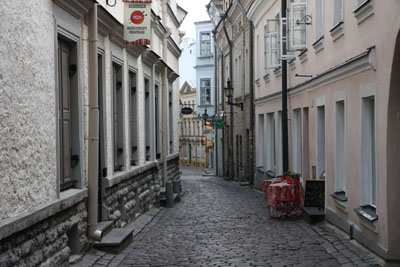 centrally
located, the room is spacious and of reasonable quality. Behind the hotel,
the hotel has its own parking. We have a short rest and then go out to buy a
SIM card for mobile internet at a
EMT shop. There is a shop in the Viru
shopping Center just outside the city gate. It only costs 5 euros for 1 GB
and is valid for one week. We walk into the old town and have a drink at one
of the many terraces on the Town Hall Square. The weather is fine and the
town very busy with lots of tourists, who are brought in daily by the large
cruise ships that are in port. In the evening we eat at restaurant
Von
Krahli Aed. Good food in the basement restaurant with delicious Italian
wine. 80 euros, though. Later we go to the
X-baar, one of the few
gay bars in the city. It's not so busy, but it is an experience. The place
is quite large with two bars and a dance floor. After a while we go back to
the hotel and time for bed.
centrally
located, the room is spacious and of reasonable quality. Behind the hotel,
the hotel has its own parking. We have a short rest and then go out to buy a
SIM card for mobile internet at a
EMT shop. There is a shop in the Viru
shopping Center just outside the city gate. It only costs 5 euros for 1 GB
and is valid for one week. We walk into the old town and have a drink at one
of the many terraces on the Town Hall Square. The weather is fine and the
town very busy with lots of tourists, who are brought in daily by the large
cruise ships that are in port. In the evening we eat at restaurant
Von
Krahli Aed. Good food in the basement restaurant with delicious Italian
wine. 80 euros, though. Later we go to the
X-baar, one of the few
gay bars in the city. It's not so busy, but it is an experience. The place
is quite large with two bars and a dance floor. After a while we go back to
the hotel and time for bed.
Weather in Tallinn 16°C/61°F and sunny
Sunday 31 August 2014
In spite of the 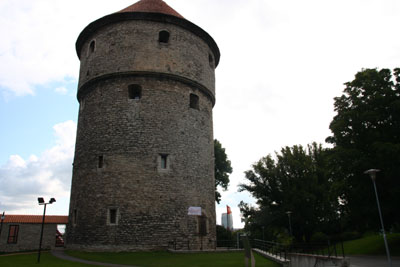 fact
that the hotel is right in the old town, we heard little or no noise from
the Saturday night street crowds. We have breakfast in the hotel pub. The
restaurant is being renovated. The range is fairly comprehensive. After
breakfast we walk to the town hall and have a coffee at the café and
chocalaterie Kehrwieder. € 4.50 is not really cheap, but it is in a nice
location. Today it is not sunny, but at least it is dry. We walk to the
Tourist Information, where our guide Merily from
Tallinn Traveller Tours
is waiting for us. She takes us for a walk through the old town. We see many
churches, city walls, the freedom square, watchtowers (Kiek-in-the-kök,
Dicke Margaret), the Parliament building, the Baltic station, fine views
over the city and much more. Merily is a talker and very entertaining. Her
comments include the history and origins of Tallinn. The Danes and the
crusaders of the Sword founded the city, which later joined the Hanseatic
League. In the 17th and 18th centuries Tallinn and Estonia belonged to
Sweden, but after the Swedish-Russian war it was annexed by the
Russian Empire. This lasted until the Russian Revolution, when the Estonians
took advantage of the chaos to declare themselves independent. They could do
so with the help of Britain and managed through the Russian Civil War and
and established the first Republic in 1920. On Freedom Square
fact
that the hotel is right in the old town, we heard little or no noise from
the Saturday night street crowds. We have breakfast in the hotel pub. The
restaurant is being renovated. The range is fairly comprehensive. After
breakfast we walk to the town hall and have a coffee at the café and
chocalaterie Kehrwieder. € 4.50 is not really cheap, but it is in a nice
location. Today it is not sunny, but at least it is dry. We walk to the
Tourist Information, where our guide Merily from
Tallinn Traveller Tours
is waiting for us. She takes us for a walk through the old town. We see many
churches, city walls, the freedom square, watchtowers (Kiek-in-the-kök,
Dicke Margaret), the Parliament building, the Baltic station, fine views
over the city and much more. Merily is a talker and very entertaining. Her
comments include the history and origins of Tallinn. The Danes and the
crusaders of the Sword founded the city, which later joined the Hanseatic
League. In the 17th and 18th centuries Tallinn and Estonia belonged to
Sweden, but after the Swedish-Russian war it was annexed by the
Russian Empire. This lasted until the Russian Revolution, when the Estonians
took advantage of the chaos to declare themselves independent. They could do
so with the help of Britain and managed through the Russian Civil War and
and established the first Republic in 1920. On Freedom Square
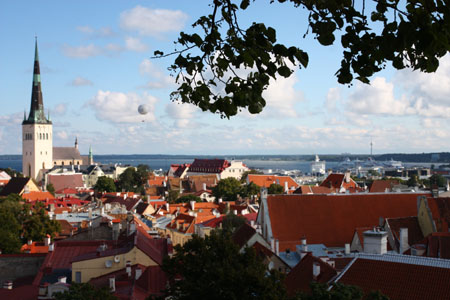 we
see the hideous monument that commemorates this republic. It is a large
square from where we go uphill. We pass the watchtower Kiek-in-the-kök
(where the guard soldiers on watch could peek into the kitchen of
surrounding houses, hence the name) and then to the Toompea hill , where the
parliament and other government buildings are located. Then we pass the St
Mary's Cathedral towards a wonderful view over the city on the Kohtuotsa
Vascular Plats. We see the Olof Church and behind it the harbor with cruise
ships and ferries to Helsinki and Stockholm. In the distance we can also
make out the outdoor theater where the singing competitions are held, which
can be heard all over the city. During the uprising in 1989 the Estonian
(and Latvian and Lithuanian) singing tradition played a prominent role in
the protests. In 1990, citizens formed a human chain from Riga to Vilnius,
singing nationalist and traditional songs.
we
see the hideous monument that commemorates this republic. It is a large
square from where we go uphill. We pass the watchtower Kiek-in-the-kök
(where the guard soldiers on watch could peek into the kitchen of
surrounding houses, hence the name) and then to the Toompea hill , where the
parliament and other government buildings are located. Then we pass the St
Mary's Cathedral towards a wonderful view over the city on the Kohtuotsa
Vascular Plats. We see the Olof Church and behind it the harbor with cruise
ships and ferries to Helsinki and Stockholm. In the distance we can also
make out the outdoor theater where the singing competitions are held, which
can be heard all over the city. During the uprising in 1989 the Estonian
(and Latvian and Lithuanian) singing tradition played a prominent role in
the protests. In 1990, citizens formed a human chain from Riga to Vilnius,
singing nationalist and traditional songs.
We arrive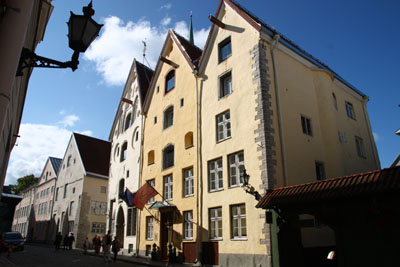 at a different viewpoint (Patkuli Vascular Platvorm) from where we descend
to the Baltic railway station. From there we walk to the Sea Gate, where one
of the guard towers is called thick Margarethe. Its walls are 4
metres thick. We walk back to the old town, past the "Three Sisters". These
are the three best preserved Hanseatic merchant houses of the city. They
have been merged into a hotel. Next we pass the Russian embassy. We end at
the Town Hall Square with the oldest working pharmacy in the world and the
Gothic town hall with the beautiful weather vane "Old Toomas". Tomas is a
legendary figure in Tallinn. The story is that the Estonian peasant boy
Toomas won an archery contest, which was organized by the German-speaking
elite of Tallinn. Because of his low-born origin, they did not want to grant
him his prize and as a consolation he got a life long job as a city guard.
Toomas used to hand out sweets to the children in the town hall square.
After his death his image was put up on the town hall steeple as a
at a different viewpoint (Patkuli Vascular Platvorm) from where we descend
to the Baltic railway station. From there we walk to the Sea Gate, where one
of the guard towers is called thick Margarethe. Its walls are 4
metres thick. We walk back to the old town, past the "Three Sisters". These
are the three best preserved Hanseatic merchant houses of the city. They
have been merged into a hotel. Next we pass the Russian embassy. We end at
the Town Hall Square with the oldest working pharmacy in the world and the
Gothic town hall with the beautiful weather vane "Old Toomas". Tomas is a
legendary figure in Tallinn. The story is that the Estonian peasant boy
Toomas won an archery contest, which was organized by the German-speaking
elite of Tallinn. Because of his low-born origin, they did not want to grant
him his prize and as a consolation he got a life long job as a city guard.
Toomas used to hand out sweets to the children in the town hall square.
After his death his image was put up on the town hall steeple as a
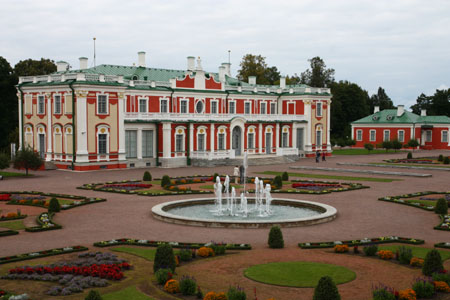 weather
vane, so that parents could reassure their children about Toomas wherabouts.
weather
vane, so that parents could reassure their children about Toomas wherabouts.
We have lunch at
Kuldse Notsu Kõrts
(the golden piglet), where we have to wait very long to get some service.
After the traditional Estonian lunch we visit the former Nicholas Church,
which is now a museum. In the church you can see a medieval painting of the
Dead Dance by Lübeck painter Nolltke. He also made a similar work in Lübeck,
but that was lost in 1942. This work is unique in its kind on canvas.
We then take the tram to the Kadriorg park. We have coffee first and then
walk into the park along the Kadriorg Palace, that Peter the Great had built
for Catherine I. Katharina - of Lithuanian / Polish peasant origin - was
first the mistress of Tsar Peter and she married him in 1707. After his
death, she succeeded him. The name of the palace and park is derived from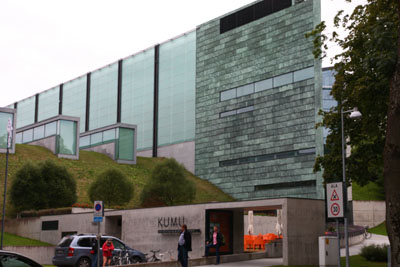 Katharina and Kadriorg means Catherine's Valley in Estonian. The palace is
beautiful and has an ornamental garden. The
Kadriorg
Art Museum is now based here and it has a broad collection of paintings
(15th to 19th century) from Breugel to Russian realists. A little further on
is the Presidential Palace. Next we see the Dutch house of Tsar Peter
himself, a very modest accommodation where the Tsar lived with Catherine
from 1714 to 1716. Peter conquered Estonia in the great Nordic War (1700-21)
on the Swedes. Opposite the Peter House is
KUMU museum of modern Art. The building designed by the Finnish
architect Vaapuori 2006 is an attraction in itself. We walk back through the
park and take the tram to the old town. In the evening we eat at the gastro
pub Hell Hunt. Do be
turned off by the name because it means "Dear Wolf". Simple but tasty food
and a good beer. We move on to have coffee at a retro-Soviet yet trendy
coffee shop. It's called Must Puudel (Black Poodle). Then back to
the hotel.
Katharina and Kadriorg means Catherine's Valley in Estonian. The palace is
beautiful and has an ornamental garden. The
Kadriorg
Art Museum is now based here and it has a broad collection of paintings
(15th to 19th century) from Breugel to Russian realists. A little further on
is the Presidential Palace. Next we see the Dutch house of Tsar Peter
himself, a very modest accommodation where the Tsar lived with Catherine
from 1714 to 1716. Peter conquered Estonia in the great Nordic War (1700-21)
on the Swedes. Opposite the Peter House is
KUMU museum of modern Art. The building designed by the Finnish
architect Vaapuori 2006 is an attraction in itself. We walk back through the
park and take the tram to the old town. In the evening we eat at the gastro
pub Hell Hunt. Do be
turned off by the name because it means "Dear Wolf". Simple but tasty food
and a good beer. We move on to have coffee at a retro-Soviet yet trendy
coffee shop. It's called Must Puudel (Black Poodle). Then back to
the hotel.
Weather: 15°C/59°F, cloudy
Monday 1 September 2014
Tallinn - Lahemaa Nationaal Park: 95km (59 mi) v.v. 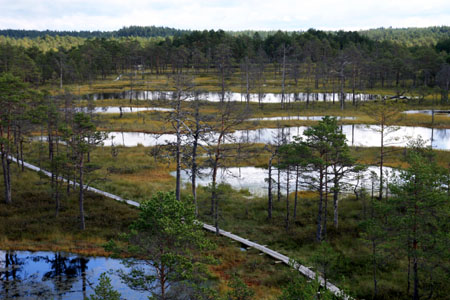
We have breakfast in the hotel pub. Then we walk to Hotel Tallinn near the
Ferry Port. We drink a coffee in the hotel and go to the Europcar desk at
the back of the hotel. Here we get a Toyota Auris (with Latvian
registration). We drive along the North coast in the direction
Lahemaa National Park.
We take the four-lane highway to the east, towards Narva. In Loksa we leave
the highway and park at a trailhead. The trail leads us into a swamp area.
Along the route there are several signs explaining the vegetation and the
bog. We get to a boardwalk which takes us over the marsh to a watchtower.
The view is beautiful. It is very quiet here. To not a soul in sight. We do
faintly hear the car noise from the highway. We take some pictures and walk
back to the car. We
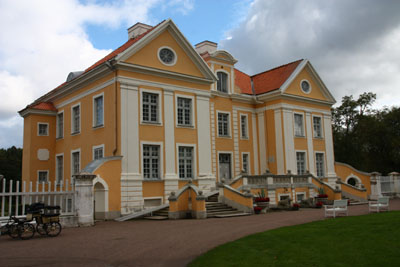 continue
to Viitna, where we use a very simple lunch at an inn. Then we continue to Palmse,
which also lies within the national park. Here is the family home of the
German Baltic noble family von Pahlen. The family stayed here from 1676
until the land reforms of 1919. In the great Northern War, when Estonia was
conquered by Russia on Sweden, the house was destroyed. In 1730 it was
restored again by Arend Dietrich von der Pahlen, who had studied
architecture in the Netherlands. In 1785 it was renovated and got its
current appearance. In 1986 the house received its authentic furniture from
the 19th century, but only one piece really is original to the building. In
the basement there is a wine shop and souvenir shop. After visiting the
house we drive to Käsmu, on the north coast and thus on the edge of the
national park. Here we walk
continue
to Viitna, where we use a very simple lunch at an inn. Then we continue to Palmse,
which also lies within the national park. Here is the family home of the
German Baltic noble family von Pahlen. The family stayed here from 1676
until the land reforms of 1919. In the great Northern War, when Estonia was
conquered by Russia on Sweden, the house was destroyed. In 1730 it was
restored again by Arend Dietrich von der Pahlen, who had studied
architecture in the Netherlands. In 1785 it was renovated and got its
current appearance. In 1986 the house received its authentic furniture from
the 19th century, but only one piece really is original to the building. In
the basement there is a wine shop and souvenir shop. After visiting the
house we drive to Käsmu, on the north coast and thus on the edge of the
national park. Here we walk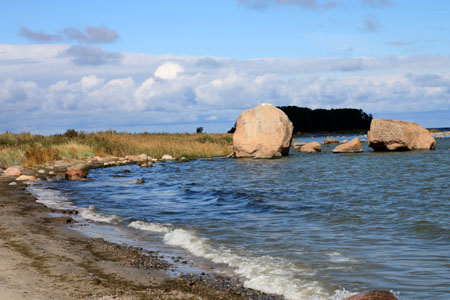 into the hamlet with the white wooden houses and along the coast to see the
huge erratic boulders lying on the beach and in the water. We make a loop of
about one and a half hours along the beach and back through the pine forest
after which we drive back to Tallinn.
into the hamlet with the white wooden houses and along the coast to see the
huge erratic boulders lying on the beach and in the water. We make a loop of
about one and a half hours along the beach and back through the pine forest
after which we drive back to Tallinn.
We later enjoy a cocktail at the bar Clazz and then after a stroll around
the center settle down in the
Ribe restaurant for a delicious dinner.
We take the three course menu: Scallops, Duck and Toffee Cake. We needed a
reservation to secure a table, but unfortunately not at the table at the
window overlooking the Apteegi and Vene street. The suggested wines were
also fine.
Weather: overcast at first. Later fine and sunshine. 16 to 18°
/ 61 to 64°F.
Tuesday 2 September 2014
Tallinn - Kuresaare 218 km / 135 mi (4:30 hrs)
fter breakfast in the pub of the hotel we drink coffee again at the Town
Hall at Kehrwieder. After coffee we drive out of town in
the direction of Pärnu. There are quite a number of road works in the city
and it's busy because of the morning rush hour, so it takes some time before
we are out of town. Once outside the city, it is completely quiet on the
road. We drive for about twenty kilometers on a motorway - good dual
carriageway to Virtsu - before we change to a two lane main road. A wider
road would have been nonsensical. Traffic is very quiet. In Virtsu we arrive
at the terminal for the ferry to the island Muhu. We have to wait 20
minutes for the next departure. Disembarking and boarding goes very fast.
Before we manage to get to the top deck, the boat has already left the
berth. The crossing over a smooth sea takes about half an hour and we pay €
13 (return). On Muhu we first buy stamps at the post office (€ 1.20 each)
and then we drive to Kuuresaare, the capital of the much larger island of
Saaremaa. Muhu and Saaremaa are connected by means of a dam. Both are very
sparsely populated islands. The western part of the island of Saaremaa was
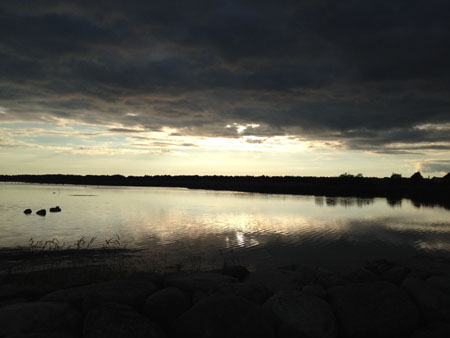 depopulated during the Soviet time, because the Soviet union deemed the area
of strategic importance. We see very few villages on our way to Kuresaare.
Kuresaare is a nice town with wooden and stone houses along a long road. We
stay at the
Georg Ots Spa hotel at the marina.
There are two spa hotels here . We have a room overlooking the harbor. The
hotel has a spa center with pool, sauna and massage treatments. We rest and
have lunch in the empty hotel restaurant. After lunch we go swimming in the
pool. There are fairly large pools with different temperatures and a couple
of saunas and steam rooms. There is also an outdoor pool. After the swim we
go into the village. Life revolves around the main square by the town hall
annex tourist info center. We buy post cards to send home and have a drink
at a side walk café. We walk around and mail the cards.
depopulated during the Soviet time, because the Soviet union deemed the area
of strategic importance. We see very few villages on our way to Kuresaare.
Kuresaare is a nice town with wooden and stone houses along a long road. We
stay at the
Georg Ots Spa hotel at the marina.
There are two spa hotels here . We have a room overlooking the harbor. The
hotel has a spa center with pool, sauna and massage treatments. We rest and
have lunch in the empty hotel restaurant. After lunch we go swimming in the
pool. There are fairly large pools with different temperatures and a couple
of saunas and steam rooms. There is also an outdoor pool. After the swim we
go into the village. Life revolves around the main square by the town hall
annex tourist info center. We buy post cards to send home and have a drink
at a side walk café. We walk around and mail the cards.
In the evening we eat at restaurant Veski Trahter based in an old (?) mill
in the center. They serve Estonian tradtional food. It fills, but it is not
memorable. Then we take a walk around the marina where Kuuresaare angling
men have taken their postions.
Weather: the day starts overcast with 12°C/54°F,
but it gets sunnier later on with temperatures of 16°C/61°F.
Wednesday 3 September 2014
We have breakfast in
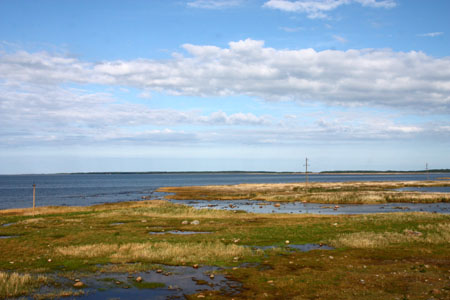 the
spacious restaurant. The range is extensive. After breakfast we drink a
cappuccino in the lobby before we drive off towards Loona on the west coast
of the island of Saaremaa. In Loona there is a Visitor Center for the
Vilsandi National Park. At the visitors centre we are
warmly welcomed and we get tips on walks of the coastal area. We drive for
nine miles on dirt roads towards the coast. Here we go for a walk and climb
a viewing tower. After having taken in the views we drive to the museum farm
Mihkli at Viki. A collection of farm buildings with old machines gathered
from all corners of the island and thrown together in a mildly organised
jumble. There's no real idea behind the exhibition, other than that the 19th
century peasant objects and implements are authentic . We continue to
Kaali,
where a meteorite crashed some 4000 years ago. The crater that was formed
the
spacious restaurant. The range is extensive. After breakfast we drink a
cappuccino in the lobby before we drive off towards Loona on the west coast
of the island of Saaremaa. In Loona there is a Visitor Center for the
Vilsandi National Park. At the visitors centre we are
warmly welcomed and we get tips on walks of the coastal area. We drive for
nine miles on dirt roads towards the coast. Here we go for a walk and climb
a viewing tower. After having taken in the views we drive to the museum farm
Mihkli at Viki. A collection of farm buildings with old machines gathered
from all corners of the island and thrown together in a mildly organised
jumble. There's no real idea behind the exhibition, other than that the 19th
century peasant objects and implements are authentic . We continue to
Kaali,
where a meteorite crashed some 4000 years ago. The crater that was formed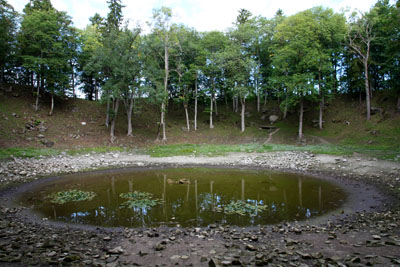 is about 110 meters wide and 20 meters deep. In the middle of it a fen has
developed. There are not many proven meteorite impacts on Earth and this is
the most accessible of all. A staircase takes down into it. The surroundings
are very undramatic: the crater is next to a kindergarten. There are eight
smaller craters in the surrounding area. We have lunch in the restaurant
which lies opposite. After lunch we drive to Angel. Here
are some typical windmills along side the of the road. The mills were used
for the production of flour until well into the 20th century. Each farm had
one or more mills. There were over 800 of them before the agricultural
collectivisation. During the Soviet the mills were neglected. These mills
can be visited in combination with some kind of local history museum with
another jumble of spinning wheels, looms and what not. From Angel it is a
short drive to the church of Karja. The ch
is about 110 meters wide and 20 meters deep. In the middle of it a fen has
developed. There are not many proven meteorite impacts on Earth and this is
the most accessible of all. A staircase takes down into it. The surroundings
are very undramatic: the crater is next to a kindergarten. There are eight
smaller craters in the surrounding area. We have lunch in the restaurant
which lies opposite. After lunch we drive to Angel. Here
are some typical windmills along side the of the road. The mills were used
for the production of flour until well into the 20th century. Each farm had
one or more mills. There were over 800 of them before the agricultural
collectivisation. During the Soviet the mills were neglected. These mills
can be visited in combination with some kind of local history museum with
another jumble of spinning wheels, looms and what not. From Angel it is a
short drive to the church of Karja. The ch urch
dates from the late 13th or early 14th century. Particularly noteworthy are
the murals with pagan elements. Decorations were also carried out by German,
Swedish and French artists. The style ranges from Romanesque to Gothic via
high-Gothic. We drive back to Kuresaare where we wash the car. It has become
quite dirty from the dirt roads back in the Vilsandi nature reserve. Erik
has a late afternoon massage at the hotel spa and I'm going to the gym and
catch some steam in the hammam.
urch
dates from the late 13th or early 14th century. Particularly noteworthy are
the murals with pagan elements. Decorations were also carried out by German,
Swedish and French artists. The style ranges from Romanesque to Gothic via
high-Gothic. We drive back to Kuresaare where we wash the car. It has become
quite dirty from the dirt roads back in the Vilsandi nature reserve. Erik
has a late afternoon massage at the hotel spa and I'm going to the gym and
catch some steam in the hammam.
On TV, we see that Obama is also in Estonia. He is here to express his
support to the Ba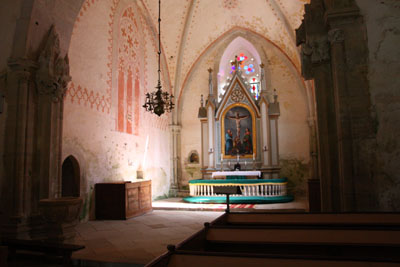 ltic
states and emphasizes that NATO strongly supports the independence of these
countries is: "You have lost your independence before. With Nato we will not
let this happen again", he says under stormy applause.
ltic
states and emphasizes that NATO strongly supports the independence of these
countries is: "You have lost your independence before. With Nato we will not
let this happen again", he says under stormy applause.
In the evening we eat in an Italian restaurant, La Perla, in the center of
Kuresaare. After dinner we walk to the castle built by the bishop
Piiskopilinnus, in the 14th century in order to keep to the islanders in
check, who were not easily evangelize. It was built by the Teutonic Knights.
In the 16th century it fell into Danish hands and in the 17th century the
Swedes had it. After the great Nordic war it the Russians took over.
Weather: cloudy start, but it gets better later when sun comes out. 18°C/64°F
Thursday 4 September 2014
Kuresaare - Pärnu 159km / 99 mi (3:10 uur)
We drive to the ferry that w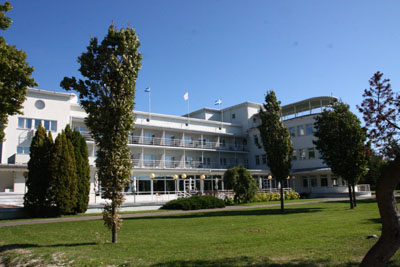 ill
take us back to the mainland. In an hour we're there and we can immediately
board the boat. The ferry departs almost instantly and a half an hour later
we are back on the mainland of Estonia. It is more than an hour's drive to
Pärnu. The weather is beautiful, the sun is shining and it's already 15
degrees. In Pärnu we stay in the
Rannahotell right on
the beach. It is a modernist building from the 1930s. A well-preserved
example of the progressive architecture of that time. A style we know in
Rotterdam from e.g. the Van Nelle Factory. We can not access the room yet,
but we are allowed to change into our shorts. The weather has become summer
like warm.
ill
take us back to the mainland. In an hour we're there and we can immediately
board the boat. The ferry departs almost instantly and a half an hour later
we are back on the mainland of Estonia. It is more than an hour's drive to
Pärnu. The weather is beautiful, the sun is shining and it's already 15
degrees. In Pärnu we stay in the
Rannahotell right on
the beach. It is a modernist building from the 1930s. A well-preserved
example of the progressive architecture of that time. A style we know in
Rotterdam from e.g. the Van Nelle Factory. We can not access the room yet,
but we are allowed to change into our shorts. The weather has become summer
like warm.
We walk into the center of Pärnu. It is a small and compact city center.
From the hotel it is no more than a fifteen minute walk. The town is very
quiet and the road to the center runs through neighborhoods with vil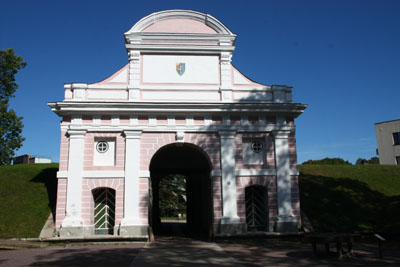 la
lined wide avenues. The houses are mostly of wood. In the center we drink
coffee first and later we go and eat at Stefani, a popular Italian
restaurant. The portions are overwhelming. My fusilini with chicken are
loaded with a load of cheese, making it incredibly filling, especially for a
lunch. I eat little more than a quarter of it. After lunch we walk to the
Rüütli, the central shopping street, where a striking number of shops have
stand empty. It takes some effort to find the Red Tower, a former defensive
work. A little further is the Magdalena guild, now a haven for artisans. We
walk on to the St. Catherine's Church, an Orthodox church built during the
reign of Catherine the Great, which has been kept in very good condition.
Reportedly, it is the most beautiful Baroque building in Estonia. It is
richly decorated with icons. We have to pay 2
la
lined wide avenues. The houses are mostly of wood. In the center we drink
coffee first and later we go and eat at Stefani, a popular Italian
restaurant. The portions are overwhelming. My fusilini with chicken are
loaded with a load of cheese, making it incredibly filling, especially for a
lunch. I eat little more than a quarter of it. After lunch we walk to the
Rüütli, the central shopping street, where a striking number of shops have
stand empty. It takes some effort to find the Red Tower, a former defensive
work. A little further is the Magdalena guild, now a haven for artisans. We
walk on to the St. Catherine's Church, an Orthodox church built during the
reign of Catherine the Great, which has been kept in very good condition.
Reportedly, it is the most beautiful Baroque building in Estonia. It is
richly decorated with icons. We have to pay 2
euros for taking pictures. We walk towards the river and to see the modern
rounded concert hall from 2002. It is now the most talked about building in
Pärnu and perhaps Estonia. We continue west to the Tallinn Gate. This one
dates from the Swedish occupation and has been built inside the last
remnants of the city wall.
After this last attraction we walk back to the hotel where our room is now
ready. The room's decorations match the architecture of the building. It's a
very small room. Later in the afternoon we go to the beach. The wind from
the sea makes it chilly. On the beach there are a lot of changing rooms and
wee see some guys kite-surfing. We drink a beer and go back to the room.
Before dinner we have a drink on the hotel terrace. We have dinner at the
Hedon hotel, a little further along the beach, where we dine at the
restaurant Raimond. Very small menu (four options per course), but very
refined cooking and flavors. The service is excellent. Back at the hotel we
watch some tv (friendly soccer match Sweden-Estonia; Ibrahimovic scored his
49th international goal, a Swedish record) and then go to sleep.
Weather: sunny 19°C / 66°F
|
|
Other Travel |
|
| back | continue |